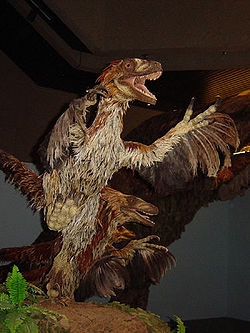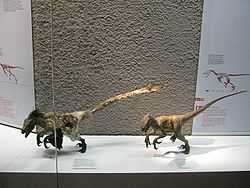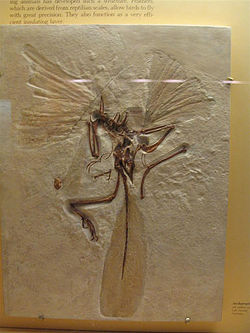

Feathered dinosaurs are theoretical transitional forms required by the evolutionist worldview, which holds that birds have evolved from reptiles in the distant past. Throughout the years, there have been many excavations that claim to have discovered dinosaurs with feathers. While there is no evidence rejecting the idea that there could have been feathered dinosaurs, there is also no evidence proving, without doubt, that there were. There is evidence that in at least some cases these so-called feathered dinosaurs are really misidentified birds. Also, most of these fossils are from China, of which they are known to have a fake fossil industry. This places a question mark on all such finds. While some evolutionists believe that dinosaurs are ancestors to our modern day birds, there is no evidence to prove it, but all the evidence against it.
A feather found fossilized in amber by evolutionary paleontologists has been dated to be around 100 million years old. By evolutionists, it is said to represent the intermediate stage of the development of feather evolution. In disagreement with these dated facts are previous findings, such as the archeopteryx. The archaeopteryx was said to be the link in dinosaur-to-bird evolution and was then dated to be 150 million years old.[1] It was also supposed to be the very first recognizable feathered bird. Another example that shows a flaw in the evolutionary theory of this feather is the confuciusornis. This beaked bird was dated to approximately 135 million years ago.[2] All the Chinese fossils indicating transitional forms from theropods to birds are dated to about 121 millions years old,[note 1] but they are 29 millions years after the first true bird. Therefore these creatures found in China couldn't possibly be the missing links to an already existing animal.[3] These birds are primary examples of how evolutionary dating is all speculative. They say that the feathered found in amber was evidence for early evolution, and yet, feathered birds survived thirty-fifty million years before the earliest feathers. The feather does not line up with other dated organisms and these fossils do not help evolutionists prove their feather evolution theory.[2]
When the evidence doesn't line up and contradicts a person's own timeline they use "ghost lineages" for the phylogeny. In order to help support the feather fossils, researchers used different techniques for dating the origin of the modern bird. The date they came up with was, at the earliest, 103 million years old. Even with the new dating, their information still leaves a three million year gap between the first birds and the first feathers. Leaving the only option to be naked, featherless birds.[2]
The feathers that were found in the amber were small and morphologically similar to down, ornamental, or afterfeathers. The smaller size of the feather could indicate that it was simply a chick and the lack of barbules could mean the degeneration of feathers that have lost their functionality. When the evidence doesn't line up with the timeline, evolutionists look past it and ignore it until it matches. Therefore, because they can not positively match up the evidence to the timeline, they can not place the feathers in a definite evolutionary chain. They make statements without finality and much hesitation. They state that there are different possibilities so that they can quickly change the facts to fit the timeline. These feathers can't be placed anywhere in the evolutionary theory because they still hold too many unanswered questions.[2]
The scales of reptiles are folds in the epidermis.[3] It is believed that the single filament evolved into the beginning stage of the protofeathers. These were made up by the thickening and elongation of the epidermis. They became hollow, narrow tubes. These were said to be found on the Sinosauropteryx. Next came either the barbed ridge or the stem. The barbed ridge contained two layers, the second created a follicle collar. The inner layer became a barbed ridge while the outer layer became a protective covering. The development of the stem or rachis had many barbs shooting away from it. Barbules, although appearing as barbed ridges, have tiny branches of barbules on the barbs. At this stage, the feather looks as if a down feather, kind of fuzzy. The complete feather is symmetrical about the stem, containing rachises, barbs, and barbules. The barbs and barbules connect and entangle with each other to form a solid surface. The very last stage, the flight feather, is asymmetrical with one side of the stem being wider than the other, allowing flight capabilities. They are found on modern birds today.[4]
There are numerous factual reasons why the dinosaur-to-bird evolution doesn't make logical sense. For example, dinosaurs, being reptiles, have scales which are folds in the epidermis. Birds have feathers which grow out of follicles. Feathers and scales are completely different in make-up and appearance. There are no known fossils presenting a transitional stage of a scale to a feather. For this even to be possible new genetic information would be necessary. Scientifically, the only way to change genetic information would be through a mutation. A major flaw in this theory is that mutations have never been recorded to increase genetic information, rather they just reduce it. Scales to feathers aren't the only characteristics needed for a dinosaur to evolve, it must also gain flight muscles, hollow bones, and a complex lung system.[3]
The digits in the forelimbs of a theropod dinosaur and those in the wings of birds are also different. Though at first scientists believed that they both shared the same digits, I-II-III, it has recently been proven otherwise. New findings have shown that birds actually have digits II-III-IV in their wings unlike their supposed prehistoric counterparts. While the theropods lost digits IV and V, the birds lost digits I and V. Through evolution the theropods would have had to morphologically regenerate. While evolving into a bird, they would have lost digit I and then regain digit IV.[3]

The avian lung is structurally unlike any other organism's. It is considered to be an irreducibly complex system, in which every part must function properly in order for it to work. The lung is dependent on both the parabronchi system and the air sac system for full working capabilities. Avian lungs do not inhale/exhale through the same passage as do mammals. Rather the air passes-through in one direction. Thus the carbon-dioxide and oxygen are not mixed in the lungs, requiring less partial-pressure and more rapid oxygen assimilation than in mammals. This causes avians to have a stilted gait when they walk, seen as comical "knee running"[5]. Unlike dinosaurs, which are depicted bent at the waist and legs, a position that avians would never, and could never assume.
This poses a problem for the step-by-step process of evolution because there is no possible way for an avian lung to survive the gradual construction process with only certain parts. Through evolution all three systems would not be in full working order for each organism, and if not, the organism wouldn't be able to survive. The vertebrate lung would not be able to evolve fast enough into an avian lung for an organism to live.[3]
When dinosaur fossils are extracted, some are found very detailed. For some fossils thought to be feathered dinosaurs, there are dark filaments found with them. Although they could possibly be actual feathers, a scientist cannot rule out other speculations. For example these filaments could be plant remains buried alongside the animal. During an in depth study of a fossil they found that through ultraviolet imaging there was a specific contrast in the colors of the bones and the supposed feathers. This tells that the 'feather' and the bones could have come from two completely different origins.[6]
There is also a chance that these filaments could be actual bird feathers fossilized alongside the dinosaur. At the same location where the dinosaur fossils were found there were also preserved bird fauna that was discovered there. Thus it is assumed that there would have been many nests. Since birds create their nests out of feathers it is postulated that during the time a natural disaster could have stirred the nests and distributed the feathers throughout the area causing them to land amongst the dinosaurs and therefore be fossilized with them. It might also be said that small dinosaurs could have also used bird feathers to build their nests, thus dying with their nests could mean they were fossilized with the birds' feathers.[6]
Research by Alan Feduccia and colleagues in 2007 was published in Proceedings of the Royal Society B. They found that the fibers associated with these Chinese fossils is consistent with collagen fibers found in sharks, modern-day reptiles, ichthyosaurs and dinosaurs as well as individual mammalian collagen fibrils.[7]
Other evidence from the fossil record against feathered dinosaurs is the fact that fossil birds (e.g. Protoavis) appear in the Triassic ~80 million years before the predicted origin of birds. Many scientists reject the credibility of Protoavis because it was found disarticulated, but one of the fragments was a keeled sternum, which is only found in strong flying birds.
The fossil find is also corroborated by late Triassic Bird Tracks (Ricardo N. Melchor, Silvina de Valais & Jorge F. Genise, Nature 2002). There is also evidence of bird tracks in the Permian Hermit Shale, which predate the Triassic tracks (Gilmore 1927) and tracks from the Carboniferous of Nova Scotia (Sternberg 1933).
From a Biblical standpoint it is known that all flying creatures were created on the fifth day of creation. It is also stated in the Bible that all land animals, dinosaurs included, were created on day six. Therefore, they were completely different organisms from the very beginning. Creationists must be careful of the media and what is printed because they are usually biased towards evolution and against religion and thereby God. There is nothing stated in the Bible that says that dinosaurs could not have had feathers back in prehistoric times, but there is currently no evidence for a definitive statement. Even if they there were such a thing as feathered dinosaurs, there is still no proof that feathers would have evolved from scales, for they are completely different.[8]
From a Biblical view, the previously stated fossilized feathers in amber are likely to have come from a chick and then encased in amber during the Great Flood of Noah recorded in Genesis.[2]

The archaeopteryx is one of the most famous and well-known specimens in the dinosaur-to-bird evolutionary theory. By evolutionists it is said to be one a primary example of a dinosaur in a transitional phase. Others believe it to be merely another hoax, like that of the archaeoraptor in which pieces of different animals were put together to form another species.[9]
Leading experts in both the creationist and evolutionary worlds agree that the archaeopteryx is indeed a true organism. Dr. David Menton, a creationist anatomist, shows how it is a true bird with feathers capable of flight. He says it is neither a transitional form nor a feathered dinosaur, but a bird. Dr. Alan Feduccia, an evolutionist, is a bird expert at the University of North Carolina. He too agrees that the archaeopteryx is a perching bird, not a dinosaur like many others claim.[9]
Menton highlights tiny bumps that were found on the fossilized bones proving that there were, in fact, feathers attached to them by ligaments. These bumps would be impossible to create on a forgery when they were not thought to be found in the first place. It would take more than feathers to just appear on a dinosaur, they must be embedded in the bones. Feduccia also discovered a unique dendritic patterns formed in the limestone rock that the fossils were found in. These patterns are formed by precipitating manganese dioxide. These designs were found on both slabs of the fossil and when the photograph negatives were compared, the dendrites corresponded with each other. This proves that the fossil is authentic because the dendrites had to form before the stone was split.[9]
Recent discoveries have also deepened the authentication of the fossils and disproved the hoax theory. The skeletons found have pneumatized vertebrae and pelvis containing a cervical and abdominal air sac. In modern times, birds have five air sacs. It also proves that the complex avian lung had already developed in what was said to be the earliest bird, putting to question the "transitional phase". For creationists, it helps to support the Biblical standpoint that birds were created as birds and they were not meant to evolve from another organism. New computer tomography scanning gives scientists a look at the brain and shows how, although smaller than modern birds', they are three times as large as a dinosaurs and similar to that of birds. Also their ears share another similarity such as the arrangement of the cochlea length and semicircular canal proportions. The archaeopteryx was also found to have large optic lobes that are necessary for visual data when flying.[9]
Dated at 120 -136 millions of years, Caudipteryx was a flightless bird.[10]
Dated at 120-150 millions years, Protarchaeopteryx was a flightless bird.[10][11]
Dated at 140 - 120 millions years, Sinosauropteryx and Sinocalliopteryx were dinosaurs. The "feathers" were called frayed collagen fibers by evolutionist Feduccia, a claim described as "without merit" by other evolutionists, thus demonstrating even evolutionists don't agree. However, it should be noted collagen fibers are thick and furry, while these dinosaurs have a branching integument, which is probably a muscle fiber.[12][11]
Dated at 128-124 million years ("Early Cretaceous"), Microraptor gui was a four winged animal. If it is not a fake, it would seem to be a type of gliding bird (or perhaps a bit like a flying squirrel). This is supported by the three misidentified birds given above. It is also supported by the fact that for this animal to glide it would need to spread its hind legs in a manner not possible for a dinosaur.
There are reasons to question the validity of this find. All but one of the Microraptor gui fossils were purchased from a dealer. Given the proven fake fossil business in China, such fossils are suspect without extensive study, such as X-Ray and under UV light. The one fossil acutely found by the discoverers of Microraptor gui, had only one feather, and there seems to be some doubt about it actually being part of the fossil, thus its provisional status as a 'bird'.[13][14]
August 15, 1999. A small flightless bird with badly preserved integument. Chemical analyzes have supported these as feathers, but the conclusion reached was that Shuuvia was a bird. [15]
Dated at 70 million years, Gigantoraptor lacks any material evidence of feathers. Claim of feathers rests on presumed relationship to oviraptorosaurs. Gigantoraptor does not even fit the evolutionist prediction that dinosaurs shrank as they evolved feathers, since the fossil is 16 feet tall and weighed an estimated 1.5 tons in life. Discovered in China.[16][17]
Evolutionists have recently claimed velociraptor had feathers because of 'quill-knobs'.However, if you were to study these 'quill-knobs' under a high-power electron microscope then you would find that they are found in other extinct reptiles, like Leiocephalus eremitus, and that they don't actually show feathers and they are naturally occurring phenomena formed in Rigormortis. Atheists, however, are currently either unaware of this or are hiding it to prove their point.
Originally dated at 120 millions of years. Hind quarters of a micro raptor, (a dinosaur ) were connected to a bird fossil.
The Archaeoraptor hoax exposed the existence of a fake fossil business in China. It got started because complete fossils bring in more money than partial ones. This discovery has not shut down the operation, and so any fossils from China not proven to be other wise, could be assumed to be a product of the hoaxers. It should be noted that the most of the recent feathered dinosaurs are all form China, and there for suspect. It must, however, in all fairness be pointed out that the hoax was revealed by evolutionists within 3 months, indicating some quality control is applied.[18][19]
Creationist
Secular
|
|||||||||||||||||
|
|||||||||||||||||